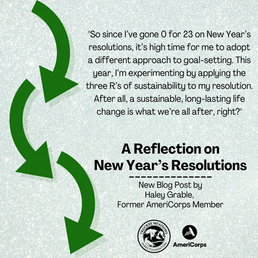Experiencing the Field of Water Quality Through My Americorps Service
Water is a natural resource that is essential for our bodies' functions and our daily activities such as showering, cleaning dishes, washing our cars, watering our gardens, and recreation. Let’s also not forget that animals and plants also need water to survive, grow, and reproduce. However, this precious and important natural resource is vulnerable to rapid human development. Humans contaminate waterways with waste, overuse it, and divert hydrological flows for our needs. All of these actions negatively impact the quality, or health, of the water, which can be detrimental to aquatic life and other organisms that depend on it—including us. This is why I think it is important to study, understand and appreciate water quality.

My interest in water quality stems from my experience as an AmeriCorps NJ Watershed Ambassador with New Jersey Department of Environmental Protection; hosted at Raritan Headwaters Association, a nonprofit watershed group. This one-year term of service opened my eyes to the importance of studying, assessing and educating the public on preserving and protecting local bodies of water. In this role, I also collected biological and visual assessments at 11 different streams for New Jersey Department of Environmental Protection. This experience exposed me to new ideas and scientific techniques regarding water sampling and I built relationships with a range of people and organizations within the field.
During my service as an AmeriCorps NJ Watershed Ambassador, I often educated community members about water pollution through presentations and tabling activities. Pollution are harmful foreign materials and substances added to the environment. When pollution enters a body of water, it can saturate the water with nutrients, decrease dissolved oxygen levels and introduce dangerous chemicals and metals; all of this endangers aquatic life. The source of pollution is also important to understand. Pollution sources are split into two categories—point source pollution and nonpoint source pollution. Point source pollution can be traced to a specific source, including storm water drains and industrial waste pipes. Nonpoint source pollution cannot be traced to a source, this includes pesticides, dog waste, storm runoff, garbage, and oils. As previously mentioned, these different pollutants decrease the health of water systems, which has led to the field of water quality.

There are various methods of measuring water quality which include chemical monitoring and visual assessments, but my favorite method is through the usage of benthic macroinvertebrates. Benthic macroinvertebrates are small, aquatic organisms that lack a backbone. They live at the bottom of rivers, lakes, and ponds, attached to woody debris and rocks, and sometimes they burrow themselves into the sediment. Macroinvertebrates are used in water quality monitoring because they only live in freshwater bodies, don’t move as much and each macroinvertebrate has a specific pollution tolerance level. These magnificent creatures can tell us so much about a stream’s health and can indicate issues with the body of water—hence why they are also called bio-indicators. I personally enjoyed collecting and counting them during my stream assessments as a NJ Watershed Ambassador because I would find various species of macros with different body types, colors, and sizes. Macroinvertebrates are great teaching tools, so I would occasionally bring live macros to presentations or events to spark curiosity, but it also provided a great way to start a conversation about water quality.

There are many significant threats to our water resources, and while it may seem like there is no solution to these problems, there are different ways to protect and improve water quality. One method is through the creation, improvement, and protection of local wetlands, such as the proposed Truckee Meadows Study Nature Area at the decommissioned Rosewood Lakes Golf Course. This project is a perfect example of how we can use existing habitats to improve water quality in a sustainable, local, and cost effective way. By restoring this area back to a functional wetland and conducting regular water quality assessments, we will be able to minimize the amount of pollution that flows into the Truckee River, improve habitats for aquatic organisms and keep track of the health of our streams. This project is in its early stages, but it will become a vital component to the local solution to our water quality issues, and I am more than happy and excited to be part of the restorations efforts.












